Minnesota is home to a diverse array of birds. From the common Red-winged Blackbird to the majestic Bald Eagle, Minnesota is home to various birds found in its grasslands, wetlands, and forests.
With habitats ranging from the tallgrass prairies of the southern part of the state to the boreal forest of the north, Minnesota provides an ideal home for various birds.
From the colorful songbirds of the spring and summer to the migrating waterfowl of the fall and winter, birders in Minnesota have a wealth of species to observe and appreciate.
49 Birds Of Minnesota
The Midwest region of the United States lies in a diverse and vibrant ecosystem known as Minnesota. Characterized by its extensive forests, expansive prairies, and countless bodies of water, Minnesota is an inviting haven for various bird species.
Here are 49 Birds Of Minnesota.
1. Northern Cardinal
The Northern Cardinal is a beautiful bird, easily identified by its bright red plumage. It can be found in the eastern United States from Maine to Minnesota and south through Mexico and Belize.
Along with its striking coloration, it has a distinctive crest on its head and sharp black facial markings around the eyes.
Despite their small size (7-9 inches), they are very vocal birds – males sing persistently throughout springtime to attract mates or proclaim their territory.
They typically feed on insects, seeds, and fruits but enjoy suet at backyard bird feeders.
The female is less brightly colored than her mate but still stands out among other songbirds due to her warm brownish-red feathers.
Cardinals pair for life, so you may often see them together in your garden or neighborhood park.
Scientific classification:
| Kingdom | Animalia |
| Phylum | Chordata |
| Class | Aves |
| Order | Passeriformes |
| Family | Cardinalidae |
| Genus | Cardinalis |
| Species | C. cardinalis |
2. American Robin

The American robin is a migratory bird belonging to the valid thrush genus and Turdidae family.
It was named after its European counterpart due to the similar reddish-orange breast they possess; however, they are not closely related.
This species can be seen through most of North America during winter months and in parts of Mexico and Central America, where it also breeds.
They have plump bodies with gray upperparts and white underparts that vary from yellow on their throats down to orange toward their bellies.
Robins feed on fruits such as berries or insects like worms,s, making them an essential part of ecosystems by helping disperse seeds naturally throughout these areas.
Scientific classification:
| Kingdom | Animalia |
| Phylum | Chordata |
| Class | Aves |
| Order | Passeriformes |
| Family | Turdidae |
| Genus | Turdus |
| Species | T. migratorius |
3. American Goldfinch
The American goldfinch is a small North American bird in the finch family. Males are vibrant yellow with black wings and tails, while females are duller in coloration.
It migrates from mid-Alberta to North Carolina during the breeding season, south of the Canada–United States border to Mexico for its wintering grounds.
The only finch that undergoes complete molt every year displays sexual dichromatism, where males have brighter colors than their female counterparts.
They feed mainly on seeds but also eat insects such as aphids and caterpillars when raising young; they often occur near thistles or other plants that produce viable seed heads.
Their call consists various chirps and trills,s making them quite conspicuous.
Scientific classification:
| Kingdom | Animalia |
| Phylum | Chordata |
| Class | Aves |
| Order | Passeriformes |
| Family | Fringillidae |
| Subfamily | Carduelinae |
| Genus | Spinus |
| Species | S. tristis |
4. Black-Capped Chickadee
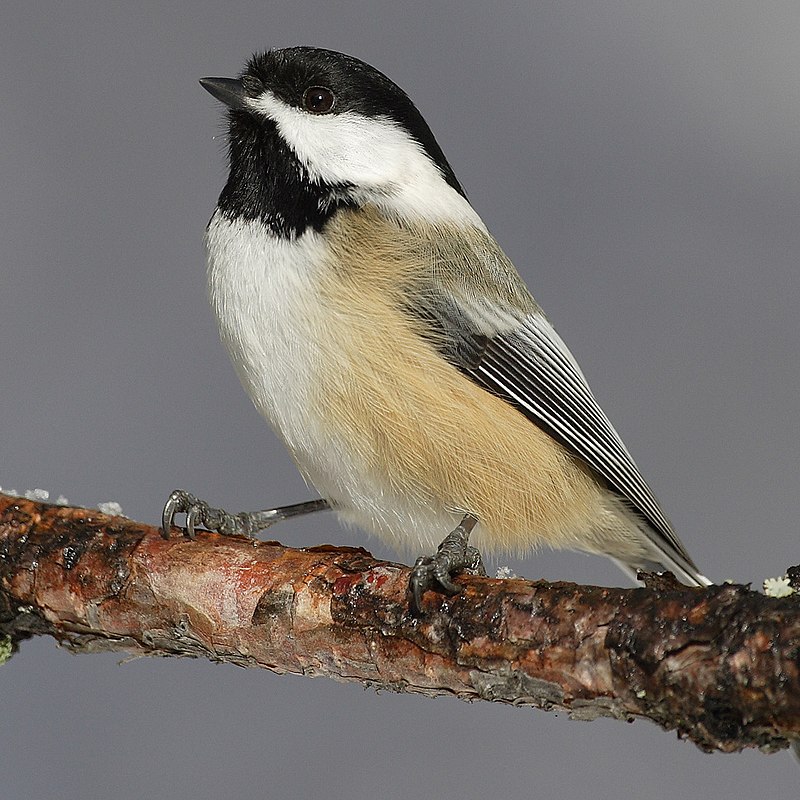
The black-capped chickadee is a small, cheerful songbirds in deciduous and mixed forests across North America. It has an iconic black cap, white cheeks, gray ba,ck, and wings with whitish barm.
The underparts are usually light-colored or greyish-brown. This species is well adapted to cold winters as it can reduce its body temperature by up to 8°C while roosting at night; this helps save energy during the year’s colder months.
It feeds mainly on insects but eats seeds, fruits, and suet from bird feeders when available.
Black-capped chickadees are popular birds among backyard visitors due to their friendly nature – they often establish lifelong partnerships with one another for breeding purposes.
Furthermore, they have been designated as state birds of Massachusetts and Maine in the USA, plus New Brunswick in Canada – a testament to how beloved these little avian friends are.
Scientific classification:
| Kingdom | Animalia |
| Phylum | Chordata |
| Class | Aves |
| Order | Passeriformes |
| Family | Paridae |
| Genus | Poecile |
| Species | P. atricapillus |
5. Woodpeckers
Woodpeckers are an incredibly diverse bird specie, found worldwide except for Australia, New Guinea, New Zealand, Madagascar,r, and the extreme polar regions.
They live various habitats,s including forests and woodland,s but also rocky hillsides and deserts with no trees.
Their beaks are adapted to pecking at tree bark to find food, such as insects or larvae hidden beneath it, while they use their long tongues to catch them from deep inside crevices.
Woodpeckers have tough skulls that protect their brains from impact when they bang into things during drumming – a behavior used by males for territorial signaling and reproduction, using solid and rapid beats against hollow objects like dead branches or metal poles.
Scientific classification:
| Kingdom | Animalia |
| Phylum | Chordata |
| Class | Aves |
| Order | Piciformes |
| Infraorder | Picides |
| Family | Picidae Leach, 1820 |
6. Common Loon
The Common Loon is a beautiful bird found in North America. It has a large black head and neck, with a greenish to purple sheen that stands out against its dark grey upperparts.
The underparts are white except for some black on the undertailcovers and vent.
During non-breeding seasons, adults have brown plumage instead of the bright shades they show during breeding season.
They also exhibit unique behaviors, such as diving underwater to catch fish or swimming along lakeshores while calling loudly, which is how they got their name “great northern diver.”
With their stunning colors and interesting behavior, it’s no wonder why these birds make up an iconic part of many landscapes across North America.
Scientific classification:
| Kingdom | Animalia |
| Phylum | Chordata |
| Class | Aves |
| Order | Gaviiformes |
| Family | Gaviidae |
| Genus | Gavia |
| Species | G. immer |
7. Barn Swallow
The Barn Swallow is a beautiful passerine bird with blue upperparts and a long, deeply forked tail. Found in Europe, Asia, Africa and the Americas.
It has an astonishingly sizeable natural distribution spanning 251 million square kilometers globe, likely making it one of the world’s most widespread species.
This swallow typically nests near human habitations other open areas such as fields or grassland, providing them with suitable invertebrate prey to feed on.
They are insectivorous birds that often fly together in flocks looking for food over rivers or marshes, usually just above tree-top level.
The barn swallow can also be identified by its strong flight of swift, continuous wing beats interspersed with glide. They hold their wings slightly raised at the shoulders, giving them distinct V-shaped silhouettes in the sky.
Scientific classification:
| Kingdom | Animalia |
| Phylum | Chordata |
| Class | Aves |
| Order | Passeriformes |
| Family | Hirundinidae |
| Genus | Hirundo |
| Species | H. rustica |
8. Red-Winged Blackbird

The red-winged blackbird is a beautiful bird found in most of North America and Central America.
Its distinct features include a glossy black body, white shoulder patches, and bright red wing coverts year round.
It prefers wetland habitats such as marshes, ponds, lakeshores,s, and agricultural fields. During breeding season, they inhabit grassy areas near water and then move south for the winter months.
For food, they mainly eat insects but also consume wild fruit or grains.
They are very social birds, often seen in large flocks during migration when their unmistakable “conk-la-ree” call can be heard echoing across the sky.
Scientific classification:
| Kingdom | Animalia |
| Phylum | Chordata |
| Class | Aves |
| Order | Passeriformes |
| Family | Icteridae |
| Genus | Agelaius |
| Species | A. phoeniceus |
9. Downy Woodpecker
The downy woodpecker is a small species of woodpecker found in North America. Growing up to 7 inches long, it can be identified by its white belly and spotted wings.
It inhabits forests throughout the United States and Canada, except for deserts in the southwest and northern tundra.
This bird nests in tree cavities and feeds mainly on insects but will supplement its diet with fruit or nuts when available.
The Downy Woodpecker has an unmistakable call that sounds like a loud ‘piker,’ similar to other members of its family, such as the Hairy Woodpecker.
Scientific classification:
| Kingdom | Animalia |
| Phylum | Chordata |
| Class | Aves |
| Order | Piciformes |
| Family | Picidae |
| Genus | Dryobates |
| Species | D. pubescens |
10. House Finch

The House Finch is a finch species native to western North America and has been introduced in the eastern half of the continent and Hawaii.
It’s an average-sized finch with adults measuring 12.5 – 15 cm (5 – 6 inches) long and with wingspans between 20 – 25 cm (8 – 10 inches).
The upperparts are brown, while its underparts range from pale grayish white to yellow depending on subspecies.
Its face is streaked or spotted with reddish coloration; males typically have brighter plumage than females due to sexual dimorphism.
They’re mostly found near human habitations such as farms and gardens, where they feed on grains, fruits, insects, etc., making them very popular among birders who want something colorful for their backyard.
Scientific classification:
| Kingdom | Animalia |
| Phylum | Chordata |
| Class | Aves |
| Order | Passeriformes |
| Family | Fringillidae |
| Subfamily | Carduelinae |
| Genus | Haemorhous |
| Species | H. mexicanus |
11. White-Breasted Nuthatch
The White-breasted Nuthatch is a medium-sized bird belonging to the nuthatch family Sittidae. It measures around 15.5 cm in length, and its color varies throughout its range.
Males have a light blue-grey upper part, with a black crown and a pe, whereas females have a dark grey crown instead of a black one.
The underparts are whitish, with reddish tinge on sides and flanks while the bill is short and stout with pale base near eyes which can be yellow or white depending upon geographic location..
This species feeds mainly on insects but will also eat seeds, nuts, and berries when available.
They prefer open woodlands where they often climb trees searching for food along trunks and branches underneath bark crevices, creating their nest there too.
Scientific classification:
| Kingdom | Animalia |
| Phylum | Chordata |
| Class | Aves |
| Order | Passeriformes |
| Family | Sittidae |
| Genus | Sitta |
| Species | S. carolinensis |
12. Song Sparrow
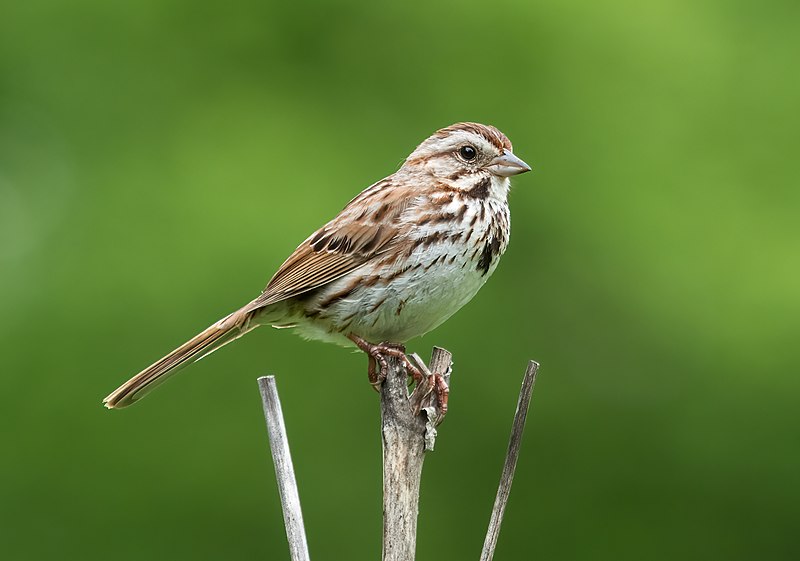
The Song Sparrow (Melospiza melodia) is a small yet abundant bird in North America.
They have brown upperparts with dark streaks and are white underneath, complete with a distinct dark brown spot on the breast.
Their cap is also brow,n and long, ground feathers can be seen sprouting from their neck area.
This sparrow species is highly variable and adaptable to many environment,s including dry brush land, wetlands or open fields.
It has been noted that adult song sparrows will sing even during winter when other birds remain quiet.
These energetic little animals make great backyard companions as they sing their lovely melodies.
Scientific classification:
| Kingdom | Animalia |
| Phylum | Chordata |
| Class | Aves |
| Order | Passeriformes |
| Family | Passerellidae |
| Genus | Melospiza |
| Species | M. melodia |
13. Mourning Dove
The Mourning Dove is a breathtakingly beautiful bird. It has stunning gray and brown feathers with white-tipped wings, giving it an elegant appearance. Its long tail also adds to its graceful look in flight.
A symbol of peace and serenity, they are abundant across North America and can be found in gardens or open fields throughout the year.
As well as being popular game birds for hunters, they feed on grains such as wheat and mille,t providing essential food sources for wildlife species,s including foxes, coyotes, skunks,s and raccoons.
These doves have a distinctive cooing sound that can often be heard echoing through woodlands during summer evenings, making them one of nature’s greatest treasures.
Scientific classification:
| Kingdom | Animalia |
| Phylum | Chordata |
| Class | Aves |
| Order | Columbiformes |
| Family | Columbidae |
| Genus | Zenaida |
| Species | Z. macroura |
14. Baltimore Oriole
The Baltimore Oriole is a small, blackbird-like bird in eastern North America. It’s named for the resemblance of its male colors to those on Lord Baltimore’s coat-of-arms from the 17th century.
These birds migrate and breed during springtime and are pretty standard in their habitats.
Studies have shown that this species interbreeds with western Bullock’s orioles, classifying both as a single species – Icterus galbula.
The males typically have orange feathers along the chest, back, wings,s and tai,l while females display tan or yellowish shades instead of bright orange like males.
Both sexes share white wing bars and dark brown ey, making them easily distinguishable among other birds.
They can often be seen flitting around trees, feeding off nectar buds or insects such as grasshoppers & caterpillars they catch while flying around.
Scientific classification:
| Kingdom | Animalia |
| Phylum | Chordata |
| Class | Aves |
| Order | Passeriformes |
| Family | Icteridae |
| Genus | Icterus |
| Species | I. galbula |
15. Red-bellied woodpecker
The Red-bellied woodpecker is a beautiful bird with an orange-red crown and nape. It breeds mainly in the eastern United States, from Florida to Canada.
This medium-sized woodpecker of the family Picidae has black wings, and white stripes on its back,k, and tail feathers barred with black.
Its underside is primarily pale yellow or white but also has some red coloration around its neck area.
Despite this subtle red hue, it should not be mistaken for the entirely red head and neck belonging to the Red-headed woodpecker of the same genus, Melanerpes carolinus.
The Red-bellied Woodpeckers’ diet consists primarily of insects such as ants, beetles, grasshoppers, nuts, fruits, berries, and tree sap, which they will feed upon at different times throughout their life cycle.
Scientific classification:
| Kingdom | Animalia |
| Phylum | Chordata |
| Class | Aves |
| Order | Piciformes |
| Family | Picidae |
| Genus | Melanerpes |
| Species | M. carolinus |
16. Gray Catbird
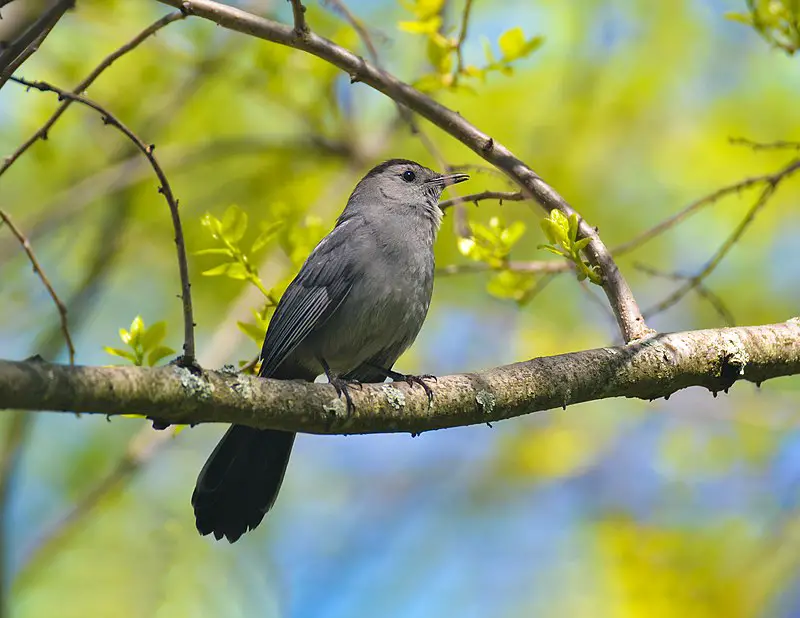
The Gray Catbird is a medium-sized bird native to North and Central America. It is the only species in its genus, Dumetella, which makes it unique among other perching birds of the Mimidae family.
Its plumage features shades of gray with some brownish tones on top and lighter grey below.
The underside of its tail has white feathers contrasting against its otherwise monochromatic coloration; this feature gives it its the name Asity, often flicks tail when alarmed or excited as cats do.
They are omnivorous but mainly feed on insects such as caterpillars, grasshoppers, and beetles, which eat fruits like berries or cherries during summers.
Despite being commonly seen alone or in pairs, these birds often flock together for protection from predators like hawks, drawn to their dark coloration against green foliage, making them harder to spot.
Scientific classification:
| Kingdom | Animalia |
| Phylum | Chordata |
| Class | Aves |
| Order | Passeriformes |
| Family | Mimidae |
| Genus | Dumetella C.T. Wood, 1837 |
| Species | D. carolinensis |
17. Blue Jay
The Blue Jay is a beautiful bird that resides in the eastern and central United States and Newfoundland,d Canada.
They have an unmistakable blue plumage with white markings on their heads and wings.
These birds are highly adaptable to habitats ranging from deciduous forests to urban areas.
As part of the Corvidae family, they are known for being intelligent problem solvers who often use tools or mimic vocalizations of other speciess, like hawks, when defending their territories.
Their diet consists mainly of insects, seeds, and nuts but can also include small vertebrates such as frogs or lizards if food resources become scarce.
Overall, these birds provide much-needed color to our environment while playing essential roles in maintaining healthy ecosystems through pollination services and seed dispersal activities.
Scientific classification:
| Kingdom | Animalia |
| Phylum | Chordata |
| Class | Aves |
| Order | Passeriformes |
| Family | Corvidae |
| Genus | Cyanocitta |
| Species | C. cristata |
18. Common Yellowthroat
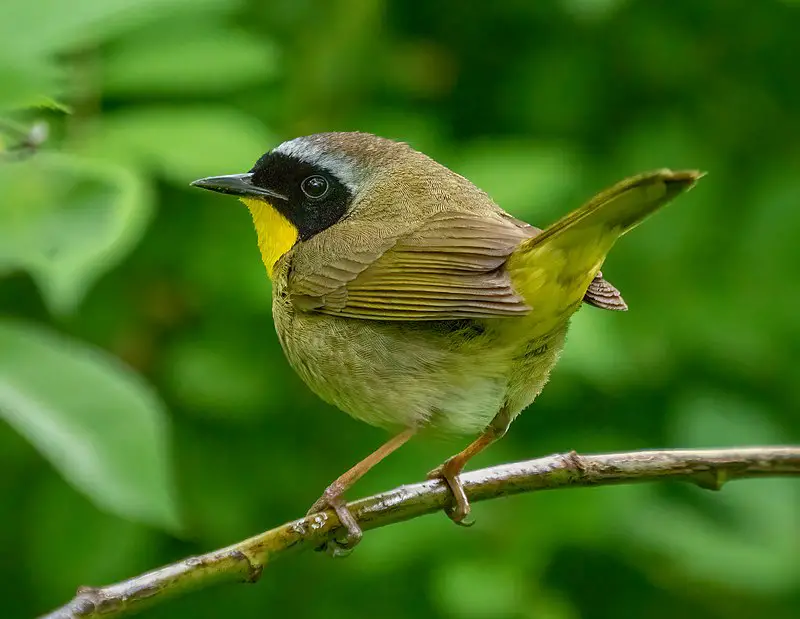
The Common Yellowthroat is a small New World Warbler found throughout North America. It has distinctive yellow and black plumage, earning it the nickname “Yellow Bandit” in the Midwest United States.
This species is highly adaptable and can be found inhabiting wetlands, grasslands, shrublands habitats, and suburban areas.
The genus of this bird’s scientific namemeansn ‘ground’ and ‘small bi,”, which are fitting characteristics for such an elusive yet familiar little creature.
Its diet consists predominantly of insects but may also include other invertebrates like spiders or worms.
Overal,l the Common Yellowthroat makes an excellent addition to any backyard with its cheerful song.
Scientific classification:
| Kingdom | Animalia |
| Phylum | Chordata |
| Class | Aves |
| Order | Passeriformes |
| Family | Parulidae |
| Genus | Geothlypis |
| Species | G. trichas |
19. Dark-Eyed Junco

The Dark-eyed Junco is a species of small, grayish sparrows found across much of temperate North America and in the Arctic during summer.
It was formally described by Carl Linnaeus in 1766, who named it after its distinctive dark eyes.
This bird has a very variable appearance due to the many different subspecies it contains, making its systematics challenging to unravel.
The plumage varies from white or light gray on their underparts with slate grey backs and wing,; black heads with white outer tail feather,; brown head stripe,; yellow bill,; pink legs and fee,;ands various shades between all these colours.
They also have considerable sexual dimorphic; ,maleses tend to be more coloucolorful females but share similar characteristics such as short tails and rounded bodies – both sexes being around 16 cm long when fully grown.
Scientific classification:
| Kingdom | Animalia |
| Phylum | Chordata |
| Class | Aves |
| Order | Passeriformes |
| Family | Passerellidae |
| Genus | Junco |
| Species | J. hyemalis |
20. Common Grackle
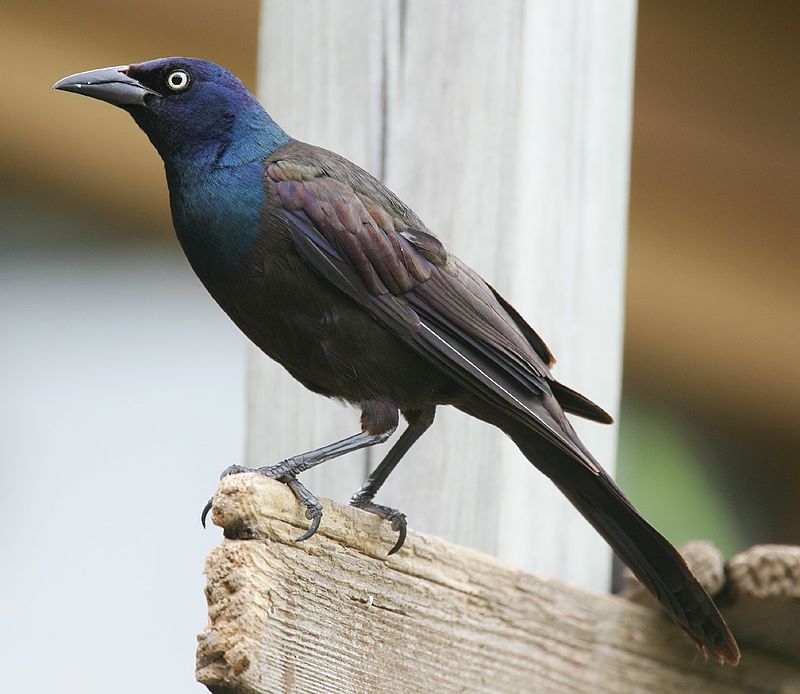
The Common Grackle is a large icterid bird commonly found in North America. It has an iridescent head and pale yellow eyes framed by its long dark bill and long tail.
Males typically have more vivid colors on their heads than females do. These birds can be seen across much of the continent, in fields, forests, wetlands – even urban areas.
They form considerable flocks to search for foo,d such as grains or insect,s that they catch with their bills.
If available, the grackles may also scavenge from human sources like garbage dumps or picnic tables. With its colorful plumage and distinct call,,thisit’secies istting this speother birds is easy.
Scientific classification:
| Kingdom | Animalia |
| Phylum | Chordata |
| Class | Aves |
| Order | Passeriformes |
| Family | Icteridae |
| Genus | Quiscalus |
| Species | Q. quiscula |
21. Chipping Sparrow
The Chipping Sparrow is a small passerine birdins most of North America. It has two subspecies, the eastern and western chipping sparrow,s which migrate seasonally to overwinter in warmer climates.
The birds are grey above with white underparts, have a rufous cap with black stripe,s and large eyes surrounded by light brown feathers.
They feed mainly on seeds but can also be seen eating insects during breeding season when raising their young chicks.
Thesebraved little birds live in open grasslands such as prairies or meadow,, buildingd cup-shaped nests in trees or shrubs to raise their young family.
Their cheerful song often sounds like ‘chips’, ‘ence ‘ts name: Chipping Sparrow.
Scientific classification:
| Kingdom | Animalia |
| Phylum | Chordata |
| Class | Aves |
| Order | Passeriformes |
| Family | Passerellidae |
| Genus | Spizella |
| Species | S. passerina |
22. House Wren
The House Wren is a small bird of theWrenn family foundinm Canadaando South America. It’s pretIt’syommon in suburban areas and is one of the most widely distributed native birds in North and South America.
Its taxonomy can be complicated, with some subspecies groups considered separate species.
The House Wren has a brown back, grey head, white eyebrow stripes, light chestnut bell,y and buffy flanks.
They often inhabit old or abandoned buildingsands shrublands near fields or open woods for nesting sites.
During breeding season, they are highly territorial, so make sure you create an inviting environment if you wish to invite them into your yard.
Scientific classification:
| Kingdom | Animalia |
| Phylum | Chordata |
| Class | Aves |
| Order | Passeriformes |
| Family | Troglodytidae |
| Genus | Troglodytes |
| Species | T. aedon |
23. Common Starling

The Common Starling is a medium-sized passerine bird that belongs to theStarlingg family. It has glossy black plumage with a metallic sheen, andat ea,r it can besprinkledd with at certain times of yearwhite.
The bill and legs are typically pink or black depending on the season, while its length measures about 8 inches long.
Its diet consists mainly of insects but also includes small fruits and seeds and some human food waste.
They live in large flocks, which protects predators, although they can become quite aggressive when defending their nesting sites during breeding seasons.
Overall, this species is highly adaptable and widely distributed across many parts of Europ,e making them one of the most successful birds in the region today.
Scientific classification:
| Kingdom | Animalia |
| Phylum | Chordata |
| Class | Aves |
| Order | Passeriformes |
| Family | Sturnidae |
| Genus | Sturnus |
| Species | S. vulgaris |
24. American Crow
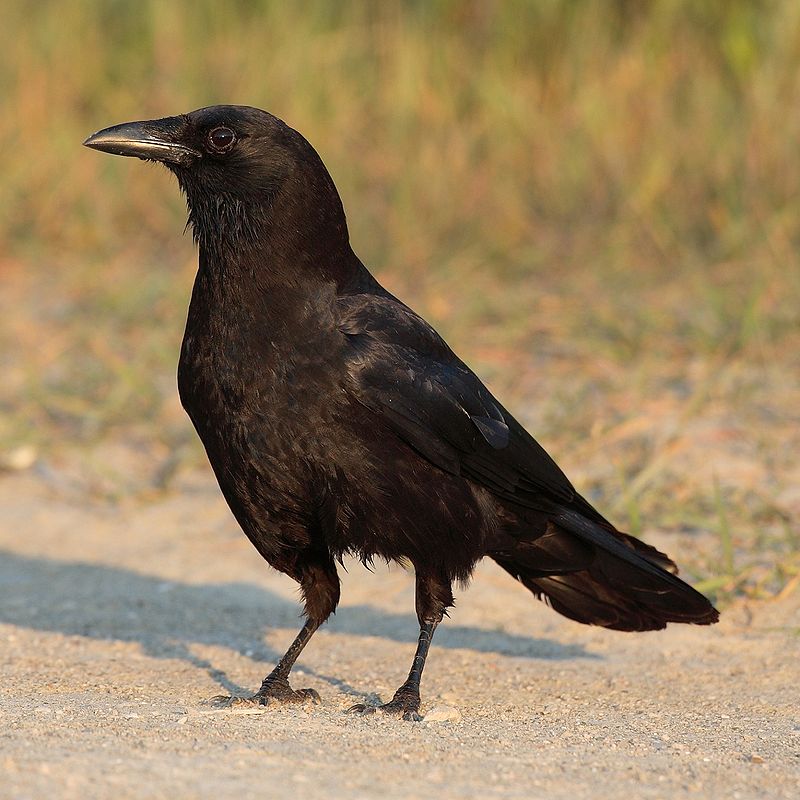
The American crow is a large bird of the Corvidae family, native to most parts of North America.
It is similar in size and structure to its European counterpart, the carrion crow,ands Eurasia’Eurasia’scrow.
The three species occupy the same ecological niche but are distinguishable by their differences in appearance.
American crows have black feathers covering their entire body, with wingspans averaging between 17-21 inches wide for males and 16-19 inches for females.
They feed on insects such as grasshoppers, beetles, and caterpillars; they also eat grains from fields or abandoned farms during winter when food sources become scarcer.
In addition to feeding habits, American crows can be identified by their distinct call, which resembles a “caw” so”nd “hat travels long distances over open terrain, making them popular among birdwatchers.
Scientific classification:
| Kingdom | Animalia |
| Phylum | Chordata |
| Class | Aves |
| Order | Passeriformes |
| Family | Corvidae |
| Genus | Corvus |
| Species | C. brachyrhynchos |
25. Loons
Loons are an aquaticbirdsd found in both North America and northern Eurasia. They can be identified by their size, similar to that of large ducks or small geese.
When swimming, loons resemble these birds in shape as well as movement.
Unlike other waterfowl, however, they have pointed bills with serrated edges and feet set far back on their bodies; this makes them excellent swimmers but hinders their ability to walk on land properly.
Loons feed mainly on fish but also eat insects and crustaceans when available.
In addition to being a common sight around lakes during warmer months, many species migrate south for winter,r where they live near coastal waters until returning in springtime.
Scientific classification:
| Kingdom | Animalia |
| Phylum | Chordata |
| Class | Aves |
| Order | Gaviiformes |
| Family | Gaviidae Coues, 1903[1] |
| Genus | Gavia Forster, 1788 |
26. Brown-Headed Cowbird
The Brown-headed Cowbird is a small, obligate brood parasitic icterid native to temperate and subtropical North America. It has a brown head with glossy black plumage on the body, wing,s and tail feathers.
During summe, itit can be found in prairies, grasslan, andas open wooded area,s but during winte,,r they migrate southwards towards the United States of Mexico for warmerclimatese.
They are mainly insectivorous birdsthat feed on insects like caterpillars or beetles and consume some grains.
The female bird lays its eggs in nests of other species then incubates them until hatching time,e thus leaving their chicks uncared for by themselves.
Scientific classification:
| Kingdom | Animalia |
| Phylum | Chordata |
| Class | Aves |
| Order | Passeriformes |
| Family | Icteridae |
| Genus | Molothrus |
| Species | M. ater |
27. Yellow-Rumped Warbler
The Yellow-rumped Warbler (Setophaga coronata) is a migratory bird species found throughout North America.
It has an extensive range, from the Pacific and Atlanticcoastss of the US to Canada and Central America, with a concentration in northern areas duringthe breeding season.
These birds migrate southwards for wintering ground,s where they find plentiful food sources such as insects and berries.
They are easily identified by their yellow patches on either side of their tails, white underparts, gray back feathers, and two distinct crown stripes.
One black or greyish-brown above the eyes extends towards its neck is banded in yellow or light brown.
Furthermore, these singers have strong legs, which allow them to cling onto branches while hunting for prey, making them adept at maneuvering through tree cover quickly.
Altogether, this makes the Yellow-rumped Warbler an attractive backyard visitor year-round.
Scientific classification:
| Kingdom | Animalia |
| Phylum | Chordata |
| Class | Aves |
| Order | Passeriformes |
| Family | Parulidae |
| Genus | Setophaga |
| Species | S. coronata |
28. Eastern Bluebird
The Eastern bluebird is a small migratory thrush found in open woodlands, farm,s and orchards across North America.
The male has bright-blue breeding plumag,e which makes it easily recognizable by birders.
It producesmelodics songs such as jeew, chir-w,i and chiti WEEW wewidoo.
This widespread species was declared the state bird of Missouri back in 1927 due to its beauty and charm.
In addition to being beautiful, these birds are also beneficial for farmers because they eat insects like grasshoppers and beetles, which damage crops.
They nest in cavities, so providing nesting boxes helps them thrive even more.
With their vibrant colors, sweet melodies, and helpful nature, it’s easit’s see why the Eastern Bluebird is beloved worldwide.
Scientific classification:
| Kingdom | Animalia |
| Phylum | Chordata |
| Class | Aves |
| Order | Passeriformes |
| Family | Turdidae |
| Genus | Sialia |
| Species | S. sialis |
29. Red-Breasted Nuthatch
The Red-breasted Nuthatch is a beautiful and vocal songbird found in coniferous forests across Canada, Alaska, the northeastern United State,s andthe western US.
This small bird has blue-grey upperparts with cinnamon underparts, a white throat and face with black eye stripe,a straight grey bil,l anda black crown.
Its call sounds like a tin trumpet; it’s higit’stched yet nasal.
During mating season,n they form monogamous pairs to build their nest near tree trunks or branches at low heights off the ground,d where they lay 2 – 8 eggs at once.
They are very active little birds who love clinging to trees while searching for insect larvae or seeds within the bark of tree,s which helps control pest populations.
Scientific classification:
| Kingdom | Animalia |
| Phylum | Chordata |
| Class | Aves |
| Order | Passeriformes |
| Family | Sittidae |
| Genus | Sitta |
| Species | S. canadensis |
30. American Yellow Warbler
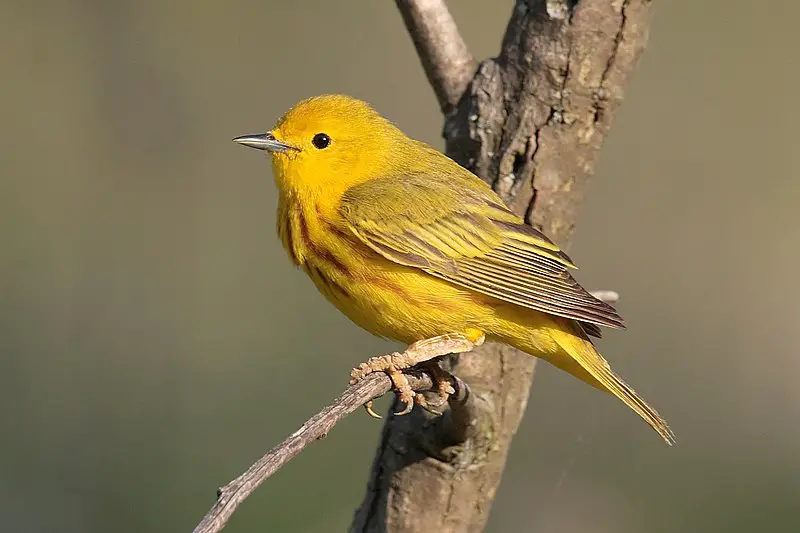
The American Yellow Warbler (Setophaga petechia) is a species of New World warbler found across North America, the Caribbea,n and northern South America.
Its genus name,e Setophag,a comes from Ancient Greek words meaning “moth” a”d “e”ting”” while”its specific name,e Petechi,a originates from Italian for tiny red spots.
This bird has striking yellow plumage with reddish-brown streaks on their chest that can be seen during mating season when they are mostcolorfull.
They live in open woodlands near wetlands or bodies of water where they can find food such as insects like spiders, beetle,s and caterpillar,s which make up much of their diet.
The male will sing to attract a mate during the breeding season before setting up a home in twig nests built by both sexes together high in trees or shrubs.
Scientific classification:
| Kingdom | Animalia |
| Phylum | Chordata |
| Class | Aves |
| Order | Passeriformes |
| Family | Parulidae |
| Genus | Setophaga |
| Species | S. petechia |
31. Purple Finch
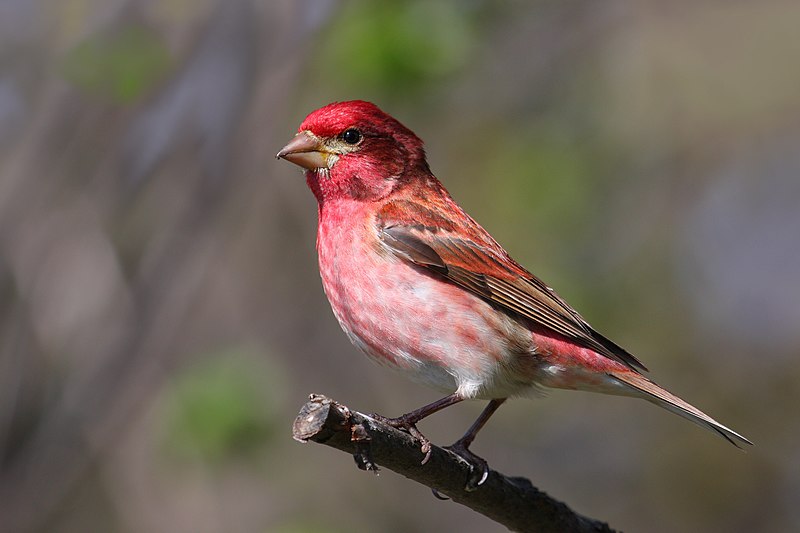
The Purple Finch is a species of finch from North Americ, belonging to the Fringillidae family.
It’s alsIt’sown as an “America” Rosefinch” due to”its resemblance in color and size to some European rosefinches.
Their plumage ranges from pinkish-purple on their heads and wing, with a light brown underside.
Small birds measure about 5-6 inches long with short, thin beaks for eating seeds and insects.
In addition, they have thick round bodies, which help them stay warm during cold winters in the northern parts of their range.
The Purple Finch has adapted well over time, making it easier for them to survivedespitee increasing threats posed by humans, such as deforestation or habitat destruction caused by development projects near their habitats.
Scientific classification:
| Kingdom | Animalia |
| Phylum | Chordata |
| Class | Aves |
| Order | Passeriformes |
| Family | Fringillidae |
| Subfamily | Carduelinae |
| Genus | Haemorhous |
| Species | H. purpureus |
32. Snowy Owl
The Snowy Owl is an impressive bird of prey native to the North American and Palearctic Arctic regions.
It has a unique white plumage that helps it blend in with its snowy tundra habita ands several adaptations that make it suitable for life in cold climates.
These include thick feathersthath insulate their bodies from frigid temperatures, large eyes adapted for hunting during long winter nights, and talons designed for gripping slippery surfaces such as ice or snow.
This majestic owl will soar high above its territory,y searching for food before gliding back down again to perch atop rocks or trees.
The Snowy Owl truly stands out amongst other birds of prey – an iconic symbol of the beauty and mystery of the north.
Scientific classification:
| Kingdom | Animalia |
| Phylum | Chordata |
| Class | Aves |
| Order | Strigiformes |
| Family | Strigidae |
| Genus | Bubo |
| Species | B. scandiacus |
33. White-Throated Sparrow
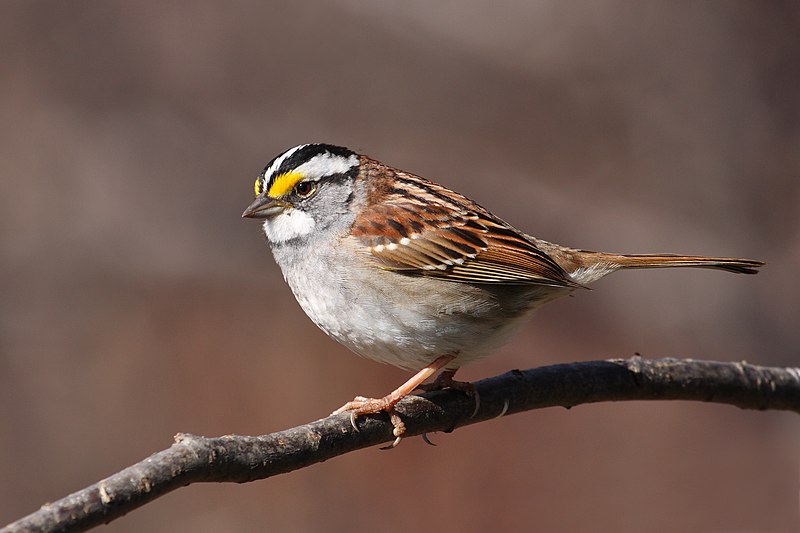
The White-throated Sparrow is a small passerine bird of the New World sparrow famil,y Passerellidae.
It has distinctive yellow and black stripes on its head, white throat,t and ches, greyy back and wings,andh light brown legs.
The scientific name “Zonotri”hia albicollis” comes “rom Ancient Greek for ‘band’ (‘ώνη,)’referring to its distinctive striped crown, and Latin for ‘white n’ck’ (albus’collum).
These birds are usually found in wooded areas such as coniferous forests or deciduous habitats in North Americ,a where they feed mainly on insects during summer month,; transitioning to seeds during winter.
They build their nests near ground level using grasses, twig,s or moss lined with feathers.
White-throated Sparrows may be solitary but also form flocks when migrating southward each fall season, which typically occurs over mid-late October through November, depending on location within range.
Scientific classification:
| Kingdom | Animalia |
| Phylum | Chordata |
| Class | Aves |
| Order | Passeriformes |
| Family | Passerellidae |
| Genus | Zonotrichia |
| Species | Z. albicollis |
34. American Redstart
The American Redstart is a beautiful New World Warbler, first documented by Carl Linnaeus in 1758.
It has an elegant black and orange plumage sets it apart from other birds.
The genus Setophaga comes from the Ancient Greek words ‘sēs,’ me’nin’ mot,h and ‘phagos” which’means eating – referencing its insect-eating habits.
Its song is joyful, with short repeating phrases making up their melodic tune.
They are mostly found hopping around trees on their long legs during breeding season but migrate to Central America for winter months when food sources become scarce in North America.
Scientific classification:
| Kingdom | Animalia |
| Phylum | Chordata |
| Class | Aves |
| Order | Passeriformes |
| Family | Parulidae |
| Genus | Setophaga |
| Species | S. ruticilla |
35. Sandhill Crane
Sandhill Cranes are a largecrane speciese native to North America and northeastern Siberia. They are known for their distinctive calls, long legs, and long necks.
These birds typically inhabit wetland areas like the Platte River in NebraskaNebraska’sls on the Great Plains.
In Central Florida, they often gather at the edges of bodies of water such as lakes or rivers.
Duringthe breeding season, sandhill cranes can be seen performing elaborate courtship dances that involve bowing and jumping in unison with their partner.
Their diet consists mainly of plant material,l including grains, roots, tuber,s and aquatic plant,s which they obtain by pecking or digging into mudflats using their bill or fee,t respectively.
With an average lifespan between 10-20 year,s these majestic creatures make great additions to any wetland habitat.
Scientific classification:
| Kingdom | Animalia |
| Phylum | Chordata |
| Class | Aves |
| Order | Gruiformes |
| Family | Gruidae |
| Genus | Antigone |
| Species | A. canadensis |
36. Rose-Breasted Grosbeak
The Rose-breasted Grosbeak is a large, brightlycoloredd bird belonging to the Cardinal family. Males have black heads and wings, with white breasts boasting a bright rose patch.
Females are more muted incolour,, mostlyy buffy brown or greyish overall but still featuring the distinctive rose breast patch. The two sexes also exhibit marked sexual dimorphism.
These birds inhabit open woodlands across North America, where they feed on seeds gleaned from foliage and fruits such as cherries and blueberries during their breeding season, which runs from April through August each year.
Scientific classification:
| Kingdom | Animalia |
| Phylum | Chordata |
| Class | Aves |
| Order | Passeriformes |
| Family | Cardinalidae |
| Genus | Pheucticus |
| Species | P. ludovicianus |
37. Bald Eagle
The majestic Bald Eagle is a bird of prey found in North America and recognized as the national symbol of the United States.
With its distinctive white head, brown bod,y and striking yellow beak, this sea eagle has two known subspecies that form a species pair with the White-tailed Eagle.
It inhabits much of Canada, Alask,a all states in the U,S contiguous are,a and Northern Mexico near large bodies of water where they feed mainly on fish.
These birds have an impressive wingspan ranging from 1.8 to 2 meters depending on their size,e making them one of nature’snature’sgnificent creatures.
Scientific classification:
| Kingdom | Animalia |
| Phylum | Chordata |
| Class | Aves |
| Order | Accipitriformes |
| Family | Accipitridae |
| Genus | Haliaeetus |
| Species | H. leucocephalus |
38. Trumpeter Swan
The majestic Trumpeter Swan is the largest native waterfowl in North America, with a wingspan of up to 8 feet.
Found throughout Canada and parts of the United States, this beautiful bird can live for up to 20 years.
It has black legs anda bill thatise tipped yello,w as well as snow-white feathers that help it stand out in its natural habitat.
The trumpeter swan’s dswan’snsists mainly of aquatic vegetation such as roots, tubers, stems, leave,s and seed,s which they find by wading into shallow waters or grazing on land.
These birds form strong family bonds; both parents raise their young together until they reach adulthood at four.
Through conservation efforts, these incredible creatures have been brought back from near extinction, giving us all somethinguniquel to appreciate.
Scientific classification:
| Kingdom | Animalia |
| Phylum | Chordata |
| Class | Aves |
| Order | Anseriformes |
| Family | Anatidae |
| Genus | Cygnus |
| Species | C. buccinator |
39. Northern Goshawk
The Northern Goshawk is a medium-large bird of prey belonging to the Accipitridae family. It has been known as one of the true hawks, with “Accipit”r” meanin” hawk in Latin and gentiles”” referr”ng to its noble characteristics.
They are found worldwide, most commonly in wooded areas such as forests or thicket,s where they hunt small birds and mammals.
The males have spotted grey upperparts, while females tend to be entirely brown above with some lighter barring on their underparts.
These raptors rely heavily on speed and agility when hunting from either perches or during aerial dives at high speeds for their prey,, making them formidable predators that can reach up to 40 miles per hour.
Scientific classification:
| Kingdom | Animalia |
| Phylum | Chordata |
| Class | Aves |
| Order | Accipitriformes |
| Family | Accipitridae |
| Genus | Accipiter |
| Species | A. gentilis |
40. Yellow-Headed Blackbird
The yellow-headed blackbird is a medium-sized bird with striking features – its head and neck are bright yellow, while the rest of its body is black.
It has large eyes, a pointed bil,l and long wings that help it soar through the air.
The species gets its name from Greek words meaning ‘yellow”(xanth’us) and ‘head’ (‘epha’us).
This species can be found in wetlands across North America during summe, wherere they feed on insects and other invertebrates such as snails, earthworms, spider,s and crustaceans.
During winter, theyy migrate southward for food or when temperatures drop too low for comfort.
They also form flock,s, making them more visible than solitary birds like hawks or owls. Yellow-headed Blackbirds make beautiful sounds that echo around wetland areas; these melodic calls bring joy to many nature lovers.
Scientific classification:
| Kingdom | Animalia |
| Phylum | Chordata |
| Class | Aves |
| Order | Passeriformes |
| Family | Icteridae |
| Genus | Xanthocephalus Bonaparte, 1850 |
| Species | X. xanthocephalus |
41. Great Horned Owl
The Great Horned Owl is an impressive bird native to the Americas. It is well-known for its wide range and adaptability, as it can be found in many habitats across the continent.
Its diet consists primarily of rabbits, hares, rat,s and mice; however, they are also known to consume skunks, gees,e and other birdo.
With their powerful talons capable ofeasily crushing preye, these owls have earned themselves a fearsome reputation due to their incredible strength.
Their iconic horn-like tufts on either side of its head add another layer of intimidation,n which helps them stand out from other owls in the area.
Scientific classification:
| Kingdom | Animalia |
| Phylum | Chordata |
| Class | Aves |
| Order | Strigiformes |
| Family | Strigidae |
| Genus | Bubo |
| Species | B. virginianus |
42. Pine Siskin
The Pine Siskin is a small bird from the finch family, primarily found in North America. It has an irregular migratory range and was first described by American ornithologist Alexander Wilson in 1810.
Due to its frequent presence near coniferous trees, the species gets its name pinus, which means pine tre”e” in Lat”n.
Pine siskins are known for their yellow wing bar, streakedd chest, andr perky mannerisms when perched on branches or flying around looking for food during colder months.
They feed primarily on seeds of weeds, grasses, and other plants but can also be seen consuming insects during the summertime nesting season.
Its loud calls often alert nearby birds of potential danger while they nest high up among pine tree limbs where predators cannot reach them easily.
Scientific classification:
| Kingdom | Animalia |
| Phylum | Chordata |
| Class | Aves |
| Order | Passeriformes |
| Family | Fringillidae |
| Subfamily | Carduelinae |
| Genus | Spinus |
| Species | S. pinus |
43. Scarlet Tanager
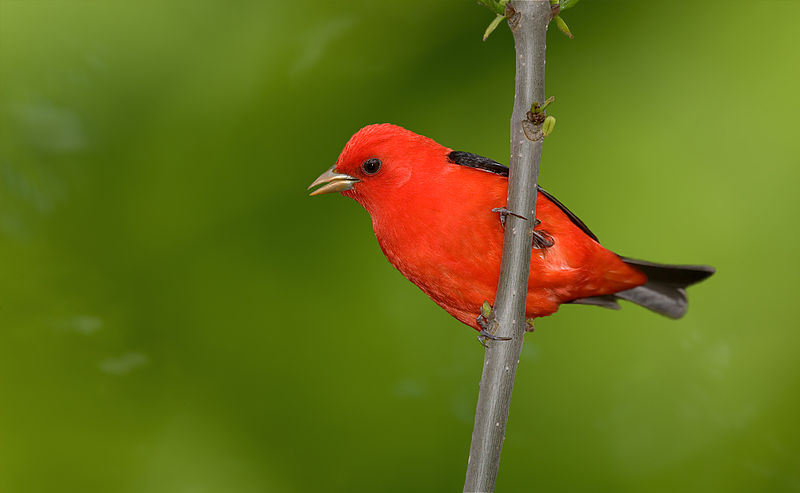
The Scarlet Tanager is a beautiful medium-sized bird in North and South America. It belongs to the Cardinal family and has striking red plumage with black wings and tail feathers.
Its song is similar to other cardinals yet also unique in its way – it’s recit’szable by its high whistles that become lower towards the end.
The species feeds mainly on insects and berries from trees or shrubs during the breeding season, when they may form loose flocks over open woodlands foraging for food.
They are highly territorial birds during nesting season, between April and June each year; both males and females fiercely defend their nests against intruders such as cats or squirrels.
Scientific classification:
| Kingdom | Animalia |
| Phylum | Chordata |
| Class | Aves |
| Order | Passeriformes |
| Family | Cardinalidae |
| Genus | Piranga |
| Species | P. olivacea |
44. Palm Warbler
The palm warbler is a small songbird in the New World, belonging to the warbler family.
It has two distinct subspecies that differ mainly in their plumage – eastern palm warblers have yellower underparts and bolder rufous streaks on their breast and flanks than western ones.
These birds are light olive above with whitish bellies and yellow throats.
They also have distinctive white-tipped tail feather,sthaty often flick while foraging or singing during breeding season, when males establish territories through song duels.
The diet of these birds consists mainly of insects such as beetles, moths, ants, and caterpillars collected from trees or ground vegetation like grasses or sedges.
Palm Warblers migrate long distances between their wintering grounds near Central America to northeastern North American states, where they breed each summer before returning south again fall.
Scientific classification:
| Kingdom | Animalia |
| Phylum | Chordata |
| Class | Aves |
| Order | Passeriformes |
| Family | Parulidae |
| Genus | Setophaga |
| Species | S. palmarum |
45. Juncos
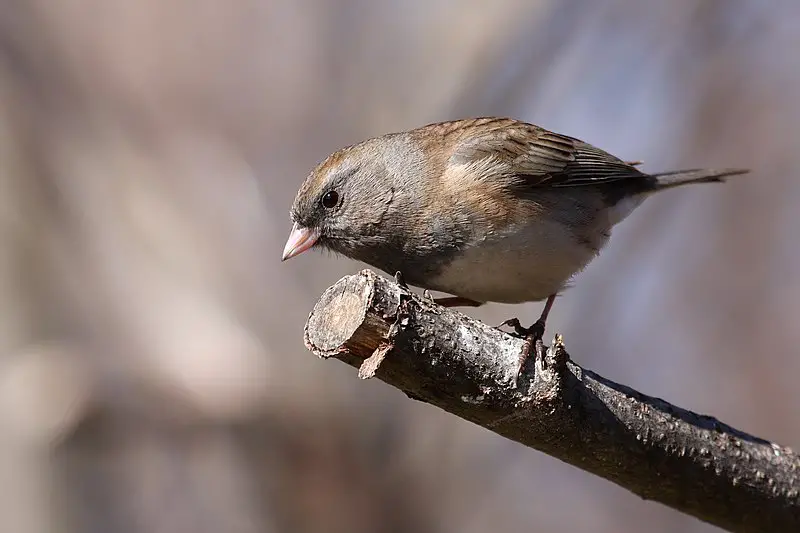
Juncos are small North American birds belonging to the Passerellidae family. Although their name appears to have Spanish origins, they rarely inhabit areas with rush plants.
Depending on species, they vary in size and color but generally have dark heads and greyish-brown bodies.
In winter, Juncos flock together to form substantial roosting groups or migrate southwards for warmer climates.
These hardy little creatures can often hop around gardens, scavenging for food during snowstorms.
Their diet consists of various items, including seeds, berries, and insects – making them popular garden visitors year-round.
Scientific classification:
| Kingdom | Animalia |
| Phylum | Chordata |
| Class | Aves |
| Order | Passeriformes |
| Family | Passerellidae |
| Genus | Junco Wagler, 1831 |
Also Featured In Most Common Winter Birds, Autumn Birds You Should Know
46. Western Meadowlark
The western meadowlark is a medium-sized icterid bird native to North America. It has a distinct yellow breast with black and white patches, making it easy to spot in open grasslands.
Its diet consists ofprimarily bugs but also includes seeds and berries. The western meadowlameadowlark’s unique – its sound is is flute-like or watery, differentiating it from the similar eastern meadowlark species.
When the nesting season arrives, they build their nests on the ground near shrubs or low trees in areas like fields and pastures.
This beautiful songbird adds life to our open lands with its melodious tunes.
Scientific classification:
| Kingdom | Animalia |
| Phylum | Chordata |
| Class | Aves |
| Order | Passeriformes |
| Family | Icteridae |
| Genus | Sturnella |
| Species | S. neglecta |
47. Double-Crested Cormorant
The double-crested cormorant is a majestic bird with an impressive wingspan, found across North America from the Aleutian Islands down to Mexico.
Its black plumage stands out against its bright orange-yellow facial skin and some extended patches of white feathers on each side of its throat.
It measures 28 – 35 inches in length and has webbed feet that enable it to swim gracefully through river, lakes, ands coastal areas.
These birds are known for their voracious appetite for fish, sometimes diving over 100 ft deep into water looking for food.
Despite this reputation, they also feed on crustaceans, amphibians, and insects when available.
Cormorants have been part of many cultures throughout history due to their remarkable ability to fly long distances, making them valued messengers or companions during fishing expeditions at sea.
Scientific classification:
| Kingdom | Animalia |
| Phylum | Chordata |
| Class | Aves |
| Order | Suliformes |
| Family | Phalacrocoracidae |
| Genus | Nannopterum |
| Species | N. auritum |
48. American White Pelican
The American White Pelican is a majestic bird from the Pelecaniformes order, known for its impressive size and ability to soar gracefully in the sky.
It breeds during summer months in North America and migrates southwards towards Central and South America during winter.
The species was first described by German naturalist Johann Friedrich Gmelin back in 1789 as part of his updated version of Carl Linnaeus’ work.
This sizeable aquatic bird has an all-white plumage with black primary flight feathers on its wings, while its beak features a characteristic yellowish coloration at the base near the face.
Its diet mainly consists of fish, it typically catches after dipping into water using its long bill; yet sometimes, they can be seen stealing food from other birds, such as cormorants or gulls.
Scientific classification:
| Kingdom | Animalia |
| Phylum | Chordata |
| Class | Aves |
| Order | Pelecaniformes |
| Family | Pelecanidae |
| Genus | Pelecanus |
| Species | P. erythrorhynchos |
49. Red-Tailed Hawk
The Red-tailed Hawk is a majestic bird of prey with a distinctive red tail. It can be found throughout North America, from Alaska in the north to Panama and the West Indies in the south.
This species belongs tothe Buteo genus,making it one of earth’s most common raptorsarthh.
These hawks mainly hunt small mammals such as rabbits or squirrels but also feed on reptiles and birds during migration season.
Unlike other predator birds, they prefer open areas for hunting,g like fields or grassland,s rather than dense forests.
They build their nests high up on trees, where they stay all year long unless humans or animals nearby disturb them.
Their presence has become an iconic part of American culture due to their frequent sightings around homes and parks alike, making them beloved creatures among people everywhere.
Scientific classification:
| Kingdom | Animalia |
| Phylum | Chordata |
| Class | Aves |
| Order | Accipitriformes |
| Family | Accipitridae |
| Genus | Buteo |
| Species | B. jamaicensis |
Conclusion
Minnesota boasts a rich diversity of bird species, providing ample opportunities for birdwatchers to observe and appreciate nature’snature’s
From majestic raptors like the Bald Eagle to melodious songbirds like the American Robin, the state’s state’shabitats support a wide range of avian life.
Whether in urban areas or pristine wilderness, Minnesota offers a birdwatching experience that is both rewarding and memorable for enthusiasts of all levels.